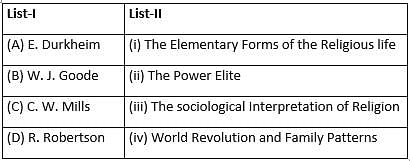UGC NET Paper 2 Sociology Mock Test - 9 - UGC NET MCQ
30 Questions MCQ Test - UGC NET Paper 2 Sociology Mock Test - 9
The actions expected of the occupant QT a position are called:
Who is the founder of Indian Institute of Science, Bangalore?
| 1 Crore+ students have signed up on EduRev. Have you? Download the App |
Positive impact on family relations Due to technological development is
What is the main aim of Smith's feminist sociology?
What regions are expected to experience much of new urbanization?
What are some negative impacts of urban sprawl as noted in the passage?
Direction In the question given below are two statements labelled as Assertion (A) and Reason (R), In the context of the two statements, which one of the following is correct?
Assertion (A) Language gives humans a means by which to negotiate meaning through symbols.
Reason (R) Naming assigned meaning, thus naming was the basis for human society and the extent of knowledge.
Which of the following statements is correct?
1. The biggest cause of the digital divide is socioeconomic inequality.
2. Broad level of education promotes the digital divide.
Which among the following are the barriers in the implementation of e-Governance?
1. Unequal access to the computer technology.
2. High initial cost for setting up the e-government solutions.
3. Digital security issues.
4. Resistance to change.
Choose the correct codes
The digital divide exists between
1. Those in cities and rural areas
2. Educated and uneducated
3. Socio-economic groups
4. More or less developed nations
Choose the correct codes
Choose the correct option.
Statement I: Media plays an important role in shaping sensibilities about the world
Statement II: Violent video games have pervasive harmful effects upon children’s mental development.
In the question given below are two statements labelled as Assertion (A) and Reason (R). In the context of two statements, which one of the following is correct?
Assertion (A): Culture is a way of life.
Reason (R): Culture is a complex phenomenon which includes knowledge.
Read the following statements carefully and choose the correct answer from the options given below:
Statement A: Particularistic multiculturalism emphasizes that cultural diversity takes place within a context of unequal power, in which certain groups have customarily enjoyed advantages that have been denied to other groups.
Statement B: Pluralistic multiculturalism and particularistic multiculturalism are not two different terms, and they share common characteristics.
Assertion (A) Art is the use of mental and physical skills, which is based on creativity.
Reason (R) Form of creation, freedom, imagination beauty worship holds important place in arts.
Choose the correct option from below:
Survey Training Institute, Hyderabad established under:
Which of the following could be classified under the software of educational technology
Polar Stratospheric Clouds are associated with which of the following environmental issues?
Which of the following is true of a community but not of institution?
What is the major attribute of Correlation Analysis?
Who among the following has clarified 'Mana' belief as a major factor in the origin of caste system in India?
What does the longitudinal research approach actually deal with
Match List-I with List-II and select the correct answer from the codes given below:

A, B, C, and D are respectively.
Which one of the following approaches mainly focuses on Consciousness?

















